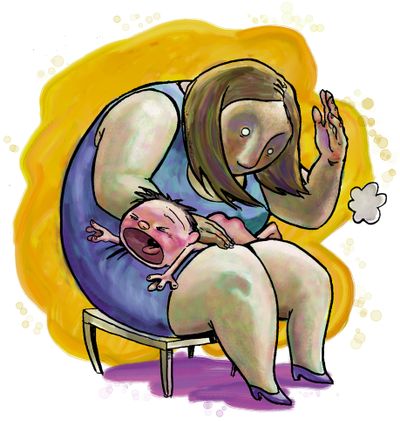LOVE TAPS
Parents who believe a little swat on the rear end is a good teaching tool defend themselves against those who believe there’s no reason to spank a child

To spank or not to spank?
It’s a dilemma faced by many good parents.
Although corporal punishment is considered a human rights violation and banned in more than 20 countries, many moms and dads in the United States consider an occasional swat on the bottom or a slap on the hand as effective forms of discipline.
In fact, recent polls show that a majority of Americans approve of corporal punishment at home. Some say that as long as it’s not the primary form of discipline, the limited use of spanking can actually work for families.
Inevitably, people tend to take sides on this controversial issue.
Opponents of spanking often point to studies that show a strong correlation between corporal punishment and increased child aggression and antisocial behavior. Children who are spanked grow up to become adults who are more likely to use physical violence against their spouses, have sadomasochistic tendencies and to suffer from depression, according to Murray Straus, sociologist and founder of the Family Research Lab at the University of New Hampshire and a researcher whose conclusions are based on the study of more than 9,000 families.
Celine Hervieux-Payette, a lawmaker in Canada who has proposed an anti-spanking bill to the House of Commons, puts it this way: “When it is an adult who is hit, we call it assault. When it is an animal, we call it cruelty. And when it is a child, we call it discipline. We need to change that perception.”
Those on the other side of the issue, however, say spanking is absolutely necessary to ensure that children know the difference between right and wrong. They also blame many of society’s ills on “permissive parenting” and the fact that a growing number of parents nowadays choose not to spank.
James Dobson, a conservative Christian psychologist and founder of Focus on the Family, is perhaps the best-known proponent of corporal punishment. While some kids can be disciplined with the use of words and a stern look, others require “strong and even painful disciplinary measures to make a vivid impression,” he writes.
On his Web site, the author of “Love Must Be Tough,” says that it’s appropriate for parents to spank their children as early as 18 months.
“Suppose a child is reaching for an electric socket or something that will hurt him,” Dobson writes on his Web site. “You say, ‘No!’ but he just looks at you and continues reaching toward it. … I’d encourage you to speak firmly so that he knows he is pushing past the limits. If he persists, slap his fingers just enough to sting. A small amount of pain goes a long way at that age and begins to introduce children to realities of the physical world and the importance of listening to what you say.”
By doing this, parents establish themselves as “the benevolent boss,” Dobson writes.
“Contrary to what you have read in popular literature, this firm but loving approach to child rearing will not harm a toddler or make him violent. To the contrary, it is most likely to produce a healthy, confident child.”
Many moms and dads try to find a middle ground. Every once in a while, they say, spanking is indeed warranted. As long as a child isn’t injured or abused, an occasional swat on the bottom or a mild slap on the arm can help them focus or call attention to misbehavior.
A generation ago, most children were spanked. But nowadays, as a result of education and decades of research by child development experts, most parents try to find other ways to address bad behavior.
At the Vanessa Behan Crisis Nursery, moms and dads enrolled in the free parenting classes often discuss spanking – whether or not they were spanked as a child, what spanking means to them and their attitudes on corporal punishment. Instructors, however, don’t tell parents whether or not to spank.
“It can be a pretty hot topic,” acknowledges Dina Patrick, the nonprofit’s program director. “We try not to make a judgment call.”
Instead, parenting experts try to provide information by distinguishing between “discipline” and “punishment.”
“Discipline is teaching and guidance,” Patrick explains. “It requires creativity and it requires follow-through.” While discipline is something parents have to constantly do, punishment, on the other hand, is about trying to immediately stop a behavior. But punishment can be short-term, says Patrick, “because you have nothing to replace the behavior so the behavior comes back. … With punishment, there is no teaching moment.”
Parents sometimes tell Patrick and others at the center that they spank “only as a last resort.” When this happens, Patrick reminds them of the need to be aware of their own anger and frustration when dealing with their children. “If you’re spanking as a last resort, then you’re often at your last resort with your patience and you may not have a lot of rationality left,” she says. “You may not realize how hard you’re spanking or how many times you’ve already spanked your child.”
While taking the 10- to 12-week “Positive Approach to Parenting” or the follow-up course called “The Nurturing Program,” parents at Vanessa Behan spend time exploring ways to discipline their children in a kind yet firm manner. This might entail praising a child for good behavior and perhaps the use of re-direction when they’re doing something they shouldn’t. It’s important for mothers and fathers to have an array of parenting tools in their tool box, according to parenting experts.
Patrick also emphasizes the need to be proactive and to constantly be in “a teaching mode.”
For parents, she says, the challenge often becomes finding ways to always be proactive and to make discipline a priority in their very busy lives.